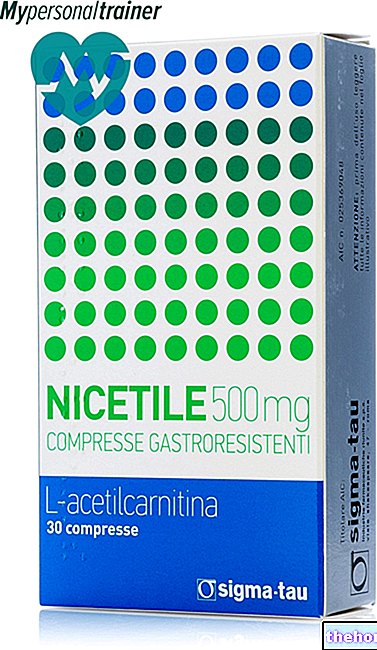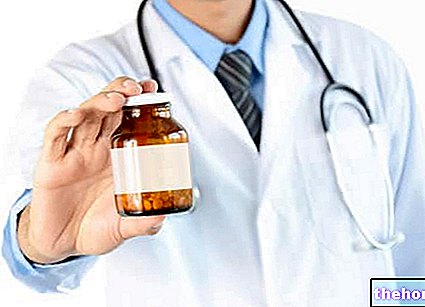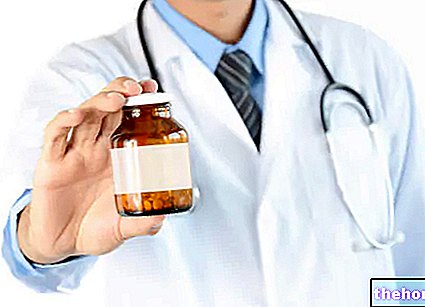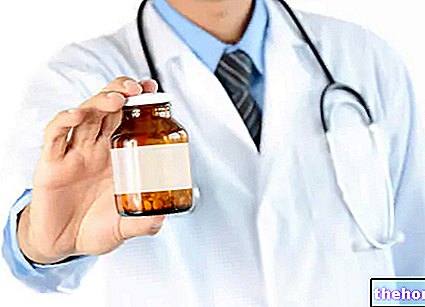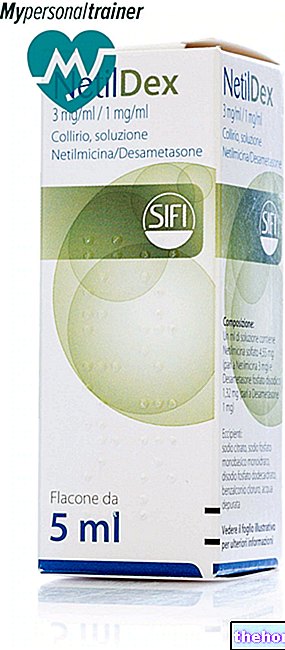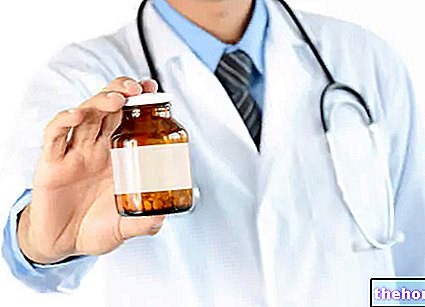Active ingredients: Metoclopramide (metoclopramide hydrochloride), Dimethicone, Potassium (Potassium citrate), Citric acid, Sodium bicarbonate
Geffer effervescent granules
Why is Geffer used? What is it for?
Geffer belongs to the therapeutic category of prokinetics (medicines that accelerate gastric emptying): it is a combination medicine aimed at the treatment of disorders resulting from gastric hyperacidity (excess acid in the stomach), overeating, abnormal presence of air and gas in the stomach and digestive di culty.
Geffer is used for the treatment of symptoms of hyperacidity (pain and heartburn), when accompanied by slowing of gastric transit (slow digestion), nausea, aerophagia and meteorism (situations characterized by abnormal accumulation of gas in the stomach or intestines. which causes belching, tension and abdominal swelling).
Talk to your doctor if you don't feel better or if you feel worse after 3 days.
Contraindications When Geffer should not be used
Don't take Geffer
- if you are allergic to the active substances or any of the other ingredients of this medicine (listed in section 6);
- if you are pregnant or breastfeeding (see "Pregnancy and breastfeeding");
- if you are "under the age of 16 (see" Children and adolescents ");
- if you are taking medicines belonging to the group of anticholinergics (medicines that inhibit the effects of acetylcholine, a neurotransmitter);
- in cases where the stimulation of intestinal motility can be dangerous, for example in the presence of gastrointestinal haemorrhage, perforation, mechanical obstruction (blockage of the intestinal tract).
- If you suffer from any of the following diseases: glaucoma (an eye disease characterized by increased pressure in the eye), pheochromocytoma (adrenal gland tumor), epilepsy, Parkinson's disease and other extrapyramidal effects (disorders of involuntary movements), porphyria, a rare disease in which the activity of particular enzymes is impaired.
Precautions for use What you need to know before taking Geffer
Talk to your doctor or pharmacist before taking Geffer.
If you are an elderly person you must not exceed 3 days of consecutive treatment and you must follow the minimum dosages indicated (see "How to take Geffer" and "Possible unwanted effects"). Children and adolescents Geffer must not be given to children under the age of 16 (see "Do not take Geffer").
Interactions Which drugs or foods can modify the effect of Geffer
Other medicines and Geffer
Tell your doctor or pharmacist if you are taking, have recently taken or might take any other medicines.
Avoid the simultaneous intake of neuroleptics (antipsychotic medicines, eg phenothiazines, butyrophenones, thioxanthenes, etc.) and sedatives (tranquilizers), if you are taking Geffer.
The sedative effects of central nervous system depressants (morna derivatives, sleeping pills, anxiolytics, sedative antihistamines, sedative antidepressants, barbiturates, etc.) and of metoclopramide are potentiated. The metoclopramide contained in Geffer increases the e ects of monoamine oxidase inhibitor medicines (used in depression), sympathomimetics (used for example to raise blood pressure) and tricyclic antidepressants. Due to the acceleration e ect of intestinal transit of the metoclopramide contained in Geffer, the absorption of some medicines may be impaired.
Metoclopramide can reduce the amount of digoxin (used in heart failure) in the blood, while it increases that of cyclosporine (used against organ transplant rejection). Reduces the central nervous system effects of apomorne (used in Parkinson's disease and erectile dysfunction).
It reduces the amount of cimetidine (ulcer medicine) in the blood, but does not appreciably change its effectiveness. Metoclopramide interacts with serotonergic medicines (eg selective serotonin reuptake inhibitors, used against depression), increasing the risk of serotonin syndrome (a severe form of intoxication).
Geffer with food, drink and alcohol
Since the sedative effects of metoclopramide are enhanced by alcohol, do not drink alcohol while taking Geffer.
Warnings It is important to know that:
Pregnancy and breastfeeding
If you are pregnant, think you may be pregnant or are planning to become pregnant, or if you are breast-feeding do not take this medicine.
Tell your doctor or pharmacist before taking any medicine.
Driving and using machines
The use of this medicine, particularly in high doses, can give rise to disorders that can decrease alertness; take this into account when driving vehicles or potentially dangerous machinery.
Geffer contains sodium
One sachet of Geffer contains 287 mg (12.5 mmol) of sodium. To be taken into consideration in people on a low sodium diet.
Geffer contains sucrose
If you have been told by your doctor that you have "intolerance to some sugars, contact your doctor before taking this medicine.
Dose, Method and Time of Administration How to use Geffer: Posology
Always take this medicine exactly as described in this leaflet or as directed by your doctor or pharmacist. If in doubt, consult your doctor or pharmacist.
The use of the product is limited to adult patients.
The recommended dose is: 1 sachet dissolved in half a glass of water, 2-3 times a day.
Do not exceed the indicated doses without your doctor's advice. In particular, elderly patients should adhere to the minimum dosages indicated above (see "Warnings and precautions" and "Possible undesirable e ects").
Geffer should be taken before meals or at the time of the onset of disorders.
Warning: after a maximum of 3 days of treatment without appreciable results, consult your doctor.
Consult your doctor if the disorder occurs repeatedly or if you have noticed any recent changes in its characteristics.
Overdose What to do if you have taken too much Geffer
In case of accidental ingestion / intake of an overdose of Geffer, notify your doctor immediately or go to the nearest hospital.
Metoclopramide can induce alterations in the state of consciousness such as drowsiness and disorientation and involuntary movements may also appear which occur mainly in the muscles of the limbs.
Prolonged use of metoclopramide can cause galactorrhea (milk secretion in men or women who are not breastfeeding) and amenorrhea (absence of menstruation).
If you have any further questions on the use of this medicine, ask your doctor or pharmacist.
Side Effects What are the side effects of Geffer
Like all medicines, this medicine can cause side effects, although not everybody gets them.
The following side effects are rare (may affect up to 1 in 1,000 patients):
- hyperprolactinemia (increased blood levels of prolactin, a hormone secreted by the endocrine glands);
- menstrual cycle disorders;
- galactorrhea (secretion of milk in males or in women who are not breastfeeding);
- gynecomastia (development of the breasts) in men;
- drowsiness;
- tiredness;
- dizziness;
- porphyria (rare disease in which the activity of particular enzymes is altered);
- extrapyramidal reactions of various types, usually of the dystonic type. They may include facial spasms, trismus (mandibular spasm that prevents the mouth from opening), spasms of the extra-ocular muscles with oculogyric crises (the eyes and eyelids are rolled), abnormal head positions; these reactions usually subside afterwards. 24 hours from the interruption of the treatment.
Hypertensive crises, sometimes fatal, have been reported in patients with pheochromocytoma (tumor of the adrenal gland); therefore the use of Geffer is contraindicated in these patients (see "Do not take Geffer").
The development of tardive dyskinesia (severe extrapyramidal-type reaction characterized by involuntary body movements), potentially irreversible, has been reported in some elderly patients treated for prolonged periods; therefore, elderly patients must absolutely avoid therapies that exceed the duration of 3 days.
Compliance with the instructions contained in the package leaflet reduces the risk of undesirable effects. These side effects are usually transient. However, when they occur, it is advisable to consult your doctor or pharmacist.
Reporting of side effects
If you get any side effects, talk to your doctor or pharmacist. This includes any possible side effects not listed in this leaflet. You can also report side effects directly via the national reporting system at www.agenziafarmaco.gov.it/it/responsabili. By reporting side effects you can help provide more information on the safety of this medicine.
Expiry and Retention
Keep this medicine out of the sight and reach of children.
Do not use this medicine after the expiry date which is stated on the sachet and carton. The expiry date refers to the last day of that month.
Do not store above 25 ° C.
Do not throw any medicines via wastewater or household waste.
Ask your pharmacist how to throw away medicines you no longer use.
This will help protect the environment.
Composition and pharmaceutical form
What Geffer contains
- The active ingredients are: metoclopramide hydrochloride, dimethicone, potassium citrate, citric acid, tartaric acid, sodium bicarbonate. One sachet of granules and ervescent contains 5 mg metoclopramide hydrochloride, 50 mg dimethicone, 94.45 mg potassium citrate, 670 mg citric acid, 152 mg tartaric acid, 1050 mg sodium bicarbonate.
- The other ingredients are: orange flavor, sucrose.
Description of what Geffer looks like and contents of the pack
Geffer is presented in the form of granules and ervescent with orange flavor, packaged in single-dose sachets. The contents of the package are 24 sachets.
Source Package Leaflet: AIFA (Italian Medicines Agency). Content published in January 2016. The information present may not be up-to-date.
To have access to the most up-to-date version, it is advisable to access the AIFA (Italian Medicines Agency) website. Disclaimer and useful information.
01.0 NAME OF THE MEDICINAL PRODUCT
EFFERVESCENT GRANULATED GEFFER
02.0 QUALITATIVE AND QUANTITATIVE COMPOSITION
Each sachet of effervescent granules contains:
active ingredients: metoclopramide hydrochloride 5 mg, dimethicone 50 mg, potassium citrate 94.45 mg, citric acid 670 mg, tartaric acid 152 mg, sodium bicarbonate 1050 mg.
For the full list of excipients, see section 6.1.
03.0 PHARMACEUTICAL FORM
Effervescent granules
04.0 CLINICAL INFORMATION
04.1 Therapeutic indications
Symptomatic treatment of hyperacidity (pain and heartburn), when accompanied by slowing of gastric transit, nausea, aerophagia and meteorism.
04.2 Posology and method of administration
1 sachet in half a glass of water before meals or at the time of the onset of disorders, 2-3 times a day.
Do not exceed the recommended doses: in particular elderly patients must follow the minimum dosages indicated above.
The use of the product is limited to adult patients.
04.3 Contraindications
Hypersensitivity to any of the active substances or excipients.
Patients suffering from glaucoma, pheochromocytoma, epileptic disease, Parkinson's disease and other overt extrapyramidal affections or undergoing therapy with anticholinergics.
Cases in which the stimulation of intestinal motility can be dangerous, for example in the presence of gastrointestinal haemorrhage, perforation, mechanical obstruction.
Patients with Porphyria.
Children under the age of 16.
Pregnancy and lactation (see section 4.6).
04.4 Special warnings and appropriate precautions for use
Avoid the simultaneous administration of neuroleptics - phenothiazines, butyrophenones, thioxanthenes, etc. - sedatives and alcohol (see section 4.5).
The use of the product can give rise to disturbances such as to alter the normal state of alertness; this should be taken into account by patients engaged in driving vehicles or operating with potentially dangerous machinery (see section 4.7).
After a maximum of 3 days of treatment without appreciable results, consult your doctor.
Elderly patients should not exceed 3 days of consecutive treatment (see section 4.8) and should adhere to the minimum dosages indicated (see section 4.2).
One sachet of Geffer contains 287 mg (12.5 mmol) of sodium: this should be taken into account in case of hypertension and in all situations requiring a controlled sodium intake (patients with congestive heart failure, renal insufficiency, nephrotic syndrome, etc.).
The product contains sucrose, therefore patients with rare hereditary problems of fructose intolerance, glucose-galactose malabsorption, or sucrase isomaltase insufficiency, should not take this medicine. The sucrose content is 2.95 g per sachet: this must be taken into account in case of diabetes or low-calorie diets.
04.5 Interactions with other medicinal products and other forms of interaction
The sedative effects of metoclopramide are enhanced by alcohol.
Anticholinergics and morphine derivatives antagonize the effect of metoclopramide on intestinal motility.
The sedative effects of CNS depressants (morphine derivatives, hypnoinducers, anxiolytics, sedative antihistamines, sedative antidepressants, barbiturates, etc.) and of metoclopramide are enhanced.
The association of metoclopramide with drugs inducing extrapyramidal effects such as phenothiazines, butyrophenones and thioxanthenes (in particular, the activity of phenothiazines is increased, regardless of the appearance or enhancement of the extrapyramidal effects) should be avoided.
It increases the effects of MAOIs, sympathomimetics, tricyclic antidepressants.
Due to the prokinetic effect of metoclopramide, the absorption of some drugs may be impaired.
Metoclopramide may reduce the bioavailability of digoxin, while increasing the bioavailability of cyclosporine.
It reduces the CNS effects of apomorphine. It reduces the bioavailability of cimetidine by about 22% on average, without however having clinically relevant consequences.
Metoclopramide interacts with serotonergic drugs (eg selective serotonin reuptake inhibitors), increasing the risk of serotonin syndrome.
04.6 Pregnancy and lactation
The product must not be used during pregnancy and during lactation (see section 4.3).
04.7 Effects on ability to drive and use machines
Metoclopramide, in high doses, can decrease alertness; this should be taken into account when driving potentially dangerous vehicles or machinery (see section 4.4).
04.8 Undesirable effects
Following the use of Geffer they can occur rarely (frequency
Systemic effects
Tiredness
Endocrine and metabolic effects
Hypertensive crises, sometimes with a fatal outcome, have been reported in patients with pheochromocytoma; therefore the use of Geffer is contraindicated in these patients.
Following the use of the product, in relation to the activity favoring the secretion of prolactin of metoclopramide, the following may occur: hyperprolactinemia, menstrual cycle disturbances, galactorrhea and gynecomastia in men.
Effects on the nervous system
With the use of metoclopramide, drowsiness, fatigue, dizziness and extrapyramidal reactions of various types, usually of the dystonic type, have been reported. These may include facial spasms, trismus, spasms of extra-ocular muscles with oculogyric crises, abnormal positions of the head; reactions usually subside 24 hours after stopping treatment.
Development of potentially irreversible tardive dyskinesia has been reported in some elderly patients treated for prolonged periods; therefore, in elderly patients, therapies that exceed the duration of 3 days must be absolutely avoided.
Effects on metabolism and nutrition
Cases of porphyria have been reported
Reporting of suspected adverse reactions
Reporting of suspected adverse reactions occurring after authorization of the medicinal product is important as it allows continuous monitoring of the benefit / risk balance of the medicinal product. Healthcare professionals are asked to report any suspected adverse reactions via the national reporting system. "address https://www.aifa.gov.it/content/segnalazioni-reazioni-avverse.
04.9 Overdose
Metoclopramide can induce neurodystonic reactions, somnolence, disorientation, especially at plasma levels> 100 ng / ml.
Dyskinesias that respond to treatment with diazepam or anticholinergics may appear. Prolonged use of metoclopramide can also cause galactorrhea and amenorrhea, linked to the stimulation of prolactin secretion.
05.0 PHARMACOLOGICAL PROPERTIES
05.1 Pharmacodynamic properties
Pharmacotherapeutic group: Prokinetics
ATC code: A03FA99
Geffer is a combination product aimed at the treatment of disorders resulting from gastric hyperacidity, overeating, abnormal presence of air and gas in the stomach and digestive difficulties.
In these conditions, symptoms such as burning, abdominal tension and gastric swelling, nausea can occur.
The metoclopramide contained in Geffer is endowed with an acceleration activity of gastrointestinal motility which results in a more rapid emptying of the stomach, as well as in a marked anti-nausea and anti-emetic action.
Dimethicone exerts an antifoam effect, which induces the crushing and elimination of air bubbles contained in the stomach and tends to reduce related symptoms.
Potassium citrate, citric acid, tartaric acid and sodium bicarbonate have a local antacid action in the stomach.
05.2 Pharmacokinetic properties
The onset of pharmacological activity of metoclopramide occurs 30 to 60 min after oral intake.
The drug is metabolized in the liver by simple conjugation processes.
Excretion is predominantly urinary.
05.3 Preclinical safety data
Metoclopramide
Acute toxicity (LD50)
mouse os> 5000 mg / kg
rat os> 5000 mg / kg
rabbit os> 5000 mg / kg
Chronic toxicity
rabbit os 30 days up to 250 mg / kg / day no toxicity
guinea pig os 48 days up to 250 mg / kg / day absence of toxicity
rat os 182 days up to 300 mg / kg / day no toxicity
dog os 120 days up to 20 mg / kg / day absence of toxicity
Teratogenesis
SD rats and NZ rabbits (absent up to 300 mg / kg per os).
06.0 PHARMACEUTICAL INFORMATION
06.1 Excipients
Orange flavor, sucrose
06.2 Incompatibility
None.
06.3 Period of validity
18 months
06.4 Special precautions for storage
Store at a temperature not exceeding 25 ° C
06.5 Nature of the immediate packaging and contents of the package
Paper / aluminum / polyethylene bags in lithographed cardboard box.
Box of 24 sachets of effervescent granules.
06.6 Instructions for use and handling
No special instructions
07.0 MARKETING AUTHORIZATION HOLDER
Bayer S.p.A. Viale Certosa 130, 20156 Milan
08.0 MARKETING AUTHORIZATION NUMBER
AIC. n. 023358068
09.0 DATE OF FIRST AUTHORIZATION OR RENEWAL OF THE AUTHORIZATION
Renewal: June 2010
10.0 DATE OF REVISION OF THE TEXT
April 2015

